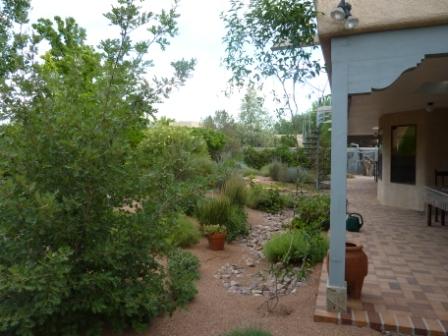
The vision of a garden humming with birds, brilliant butterflies, and singing grasshoppers probably looks a lot more like a shady bench under a dew-kissed arbor than anything here among the tumbleweeds.
So the first thing Southwest gardeners need to amend in their wildlife-friendly garden is their minds. Birds, insects, and reptiles already frequent the bosque, foothills, and mesa, and it isn’t the neatness of the shrubbery that matters to them.
A garden that attracts living creatures is basically habitat, which operates by slightly different rules than the painterly compositions or abstract Edens that have long been the aim of gardeners, East and West.
It is for articulating this somewhat contrarian perspective on gardening that Judith Phillips has become, over the last three decades, the guru of New Mexico xeriscape design. She moved to the Southwest from Indiana in the early 1970s as an anthropology student eager to explore ethnobotany—traditional uses for native plants—only to find in New Mexico gardens “the same things they were growing in Indiana!” So Phillips turned to some of the only information available about
growing native plants, scholarly papers on range regeneration and mine reclamation.
Starting with the idea that native plants are beautiful and suitable for the home garden, Phillips developed a landscape design business that grew with the interest in dry-land gardening. She is the author of Southwestern Landscaping with Native Plants (1987 and 2002), Natural by Design and its companion Plants for Natural Gardens
(1995), and New Mexico Gardener’s Guide (1998 and 2005).
We asked Judith Phillips for some simple tips for weekend gardeners who would like to provide more food, shelter, and protection for the creatures who share our high-altitude home. Here’s a summary of her advice.
Above: Along with layers of canopy and different food sources, this portal swale features runoff from the roof.
How to plant
Probably the cardinal rule for attracting wildlife to your yard is to provide diversity: Trees, shrubs, and ground cover represent the different layers of habitat frequented by various creatures.
Not only trees, but an understory is attractive to many birds as a protected place to hang out and feed. Don’t forget the middle layer of shrubs used by many desert creatures. When it comes to developing diversity in your yard, the more the better.
Of the different types of regional habitat—riparian (river valley), mesic (foothills or transition zone), and xeric (desert)—focusing on yours and including natives local to it will help to attract all possible visitors. Choose plants that do more than one thing, such as feed and shelter, and that are well adapted to our environment so they’ll be sure to produce the seed, nectar, or shade that make them assets for wildlife.
An important corollary of planting for diversity is to welcome the visitors that arrive. It may not be the creatures you the more likely you are to develop a healthy ecosystem as birds feed on bugs, and bees pollinate flowers. “If you start making a list of wildlife you want to attract, you’re opening yourself up for disappointment,” Phillips says with a smile. “You will have rabbits.”
Where to plant
The size of your habitat is not crucial. Wildlife will use whatever works, regardless of whose yard it happens to be in. “Habitat can be the size of a flower pot,” Phillips notes. Even a small ecosystem can start to build the chain of life throughout the neighborhood.
If you are new to the region, or new to gardening, it makes sense to start small. So much of gardening involves trial and error that it’s best to limit your investments of time, money, and ambition. Begin in those parts of the yard where you spend the
most time, Phillips says, since they are more likely to be observed and cared for regularly.
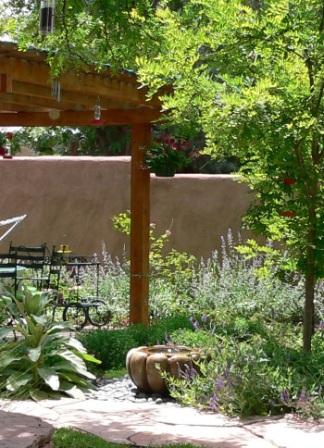
First things first: water
It goes without saying that an environment welcoming to our resident species probably does not mimic an Amazonian rainforest or the English countryside—though many people try to recreate jungle oases regardless of the cost to our shared water resources. This doesn’t mean you have to settle for an artfully arranged moonscape. Water by capturing rain off the roof and directing it to plants, either through the canales or with rain barrels.
Water is a magnet for life in the desert, especially during periods of drought. Try to include it in your garden, preferably with motion and sound. Even a small bubbling fountain can create an oasis. Alternatively, areas of lush planting can suggest water, mimicking canyon arroyos that beckon with cool shade and dense vegetation.
Opt for low-water species, and train them to live on less. While they are young, water deeply to encourage the growth of an extensive root system. Gradually increase the depth of watering (through longer drip irrigation) while also increasing the intervals between watering. Continue deep watering every six or eight weeks during winter, and
when possible as the weather warms (stopping during any cold snaps to keep plants dormant).
It usually takes three years for a plant to develop a root system that can survive on rainwater alone. But it’s worth pushing them, Phillips says, because what doesn’t kill them makes them stronger. Desert plants are damaged by too much water more often than by too little, but ideally you stop short of killing them.
Above: Even a small water source adds an element attractive to wildlife.
Feed the birds
Along with water, food is one of the main features drawing wildlife into your garden—often to the detriment of your own eating plans. Here again, diversity is the aim: Include juicy fruits (prickly pear), nectar (Russian or cherry sage), and drought-tolerant flowering trees such as desert willow, which attracts multiple species and is an excellent source of
ecosystem diversity in itself.
Seeds are an important food source that gardeners tend to avoid, since prolific self-sowing can be weedy. Consider flouting conventional gardening wisdom and let plants go to seed. Many short-lived wildflowers replant themselves by self-sowing, and seeds provide an important source of protein for birds and squirrels.
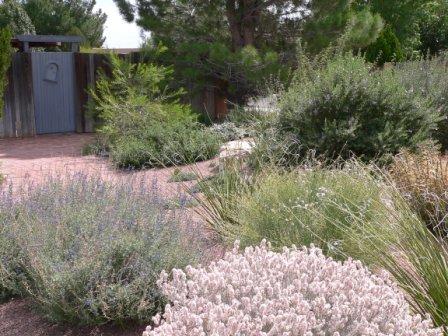
Home sweet home
Along with food and water, suitable nesting spots have grown scarcer as housing developments spring up on former open space. Placing a nesting source near a food source will multiply wildlife activity in that part of the garden.
Trees are, of course, the premier nesting habitat, and including some evergreens will provide cover all year round. Phillips considers cottonwood trees the “condominiums” of the plant world, as they provide nesting for creatures up and down the food chain. Many other trees attract multiple species and provide both food and shelter, such as hawthorn, hackberry, New Mexico olive and live oak.
Trees that grow large enough to provide shade are a great water-saving investment over the long run, though not all will accommodate plantings in their shade. Mulberry trees create such a dense cover that nothing will grow underneath. Mature pine trees can alter the soil so much that nothing will grow near them. “It’s never ‘one size fits all’” in gardening, Phillips says.
Above: The southwest corner of this North Valley home shows layers of canopy and open space, plus lots of food sources: seeds, nectar, and berries.
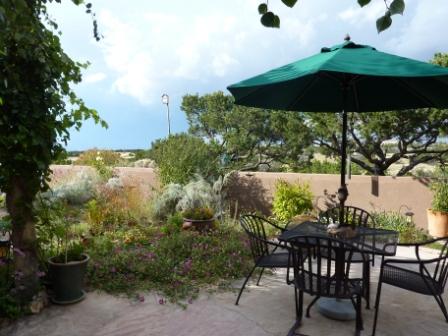
What to grow
The choices appear overwhelming at first, only to shrink seemingly to nothing once nature begins her process of elimination. Rather than clearing an area of your garden to replant, start by adding to the vegetation that is there, Phillips says. This saves water and helps the garden “fit” its environment. Besides, digging can damage tree roots, which often run far from the tree itself.
Start by researching plants you like. Browse at xeriscape nurseries like Plants of the Southwest or Great Outdoors Nursery, check out guides such as Phillips’ Plants for Natural Gardens and online resources (including the excellent garden templates at www.abcwua.org), and then try
something on a small scale. Use observation and
common sense to gauge whether a plant will fit and function in your yard. Why might the plant have evolved the characteristics it has?
Native plants are naturally going to be the ones best suited for our environment. However, climate zones have been shifting so rapidly (as gardeners know), and including greater extremes, that you want to look for native plants that grow in many different ecosystems, such as the Colorado Plateau species.
Global warming also is affecting migration calendars and ranges, sometimes making sources of food and water increasingly hard for animals to find. That makes artificial habitat like your garden even more crucial to surviving and migrating species.
Above: Even in dry environments like the foothills, plants can provide layers for feeding, roosting, and nesting.
Unwelcome visitors
Certain kinds of wildlife are a gardener’s bane. So it makes sense to fence off your “civilized” kitchen garden from its wilder neighbor. Certain plants are less palatable to rabbits, but in drought conditions they will eat anything, including cactus. Jackrabbits sometimes eat things that appear inedible, simply to file down their teeth. One solution is Ropel, a bitter but harmless spray invented by a veterinarian that is taken up by plants systemically and makes plants taste bitter (which rules it out for your vegetable garden). Spraying it on plants when they are young and tender in early spring can discourage rabbits from deciding your garden is their private buffet.
Bugs are another life form that brings out murderous impulses in the gardener. “Bugs really are important,” Phillips notes. “Birds eat them—they’re part of the food chain. People often react to bugs before they know what’s going on.” Try to figure out what type of creature is eating your plants, its habits and life cycle, before reaching for the poison.
“I used to kill white and black striped caterpillars,” Phillips says, “until I realized they turn into monarch butterflies.”
Often, a surplus of protein in nature will attract a protein-eater. “So your first response should be soft”—i.e., use your hands to pull off bugs, and see what develops. Or spray a safer product like potassium salts of fatty acids (“insecticidal soap”), which cause insects to dehydrate and die.
Finally, there are the many unwelcome plants in the garden, native or not. When it comes to weeds, annuals can easily be stopped short by mulching early in the season, Phillips says, taking care not to overly disturb the soil. Tilling and hoeing expose weed seeds to light, which starts them growing, which you don’t want. Seeds that fall on the mulch should dry out, leaving only stragglers that can be pulled or cut. The widely used herbicide Roundup, which is touted as safe, has been linked to illness of the skin, eyes, and lungs, and contains inert ingredients whose metabolites and contaminants are
known carcinogens. “If you can control with something less toxic, you’re not poisoning the land, water, or creatures including yourself,” Phillips says.
As you set out to garden in an animal-friendly state of mind, don’t forget to look after the creature at the top of the food chain: you. Gardening is a never-ending pursuit that is more a process than product. Rejoice over the visitors who reward your efforts by coming to dine, sleep, or stay. You’ve approached the perfection of the master gardener—nature herself, whose work has no beginning or end.
Judith Phillips operates a landscape design and consulting practice and teaches at UNM. For more information: www. judithphillipsdesignoasis.com
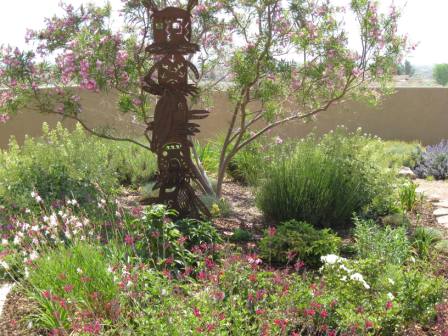
Garden Events Offer a Birds’-Eye View
Learn all you need to know about attracting hummingbirds to your yard in a free workshop from Plants of the Southwest and The Fat Finch on Saturday, March 31, from 10 a.m. to noon. Topics include using native plants to attract hummingbirds, choosing a hummingbird feeder, and advice from a garden expert. For more information, contact The Fat Finch at 898-8900, info@fatfinch.com, or Plants of the Southwest at 344-8830, plantsofthesouthwestabq@gmail.com.
Corrales Main Street will again be sponsoring the annual Corrales Garden Tour on Sunday, June 12, with help from the Sandoval County Master Gardeners. A fresh collection of six residential gardens and one demonstration garden will be open for viewing, with Master Gardeners in red aprons at each garden to answer questions, from 9 a.m. to 4 p.m. The gardens range from bosque to sandhills, with most focusing on xeric landscapes. Tickets cost $10 and will be available starting May 1 at Frontier Mart, Village Mercantile, and Oasis restaurant in Corrales. Proceeds will support a landscaping project planned for Corrales Road. Visit www.corrales-gardentour.com or contact 350-3955 or info@corralesgarden tour.com.
